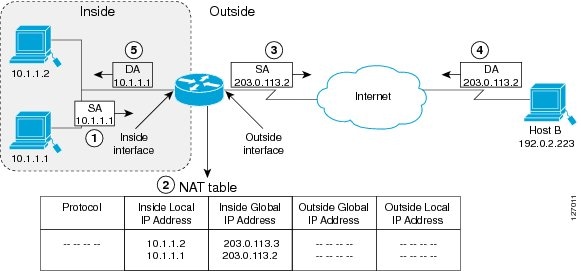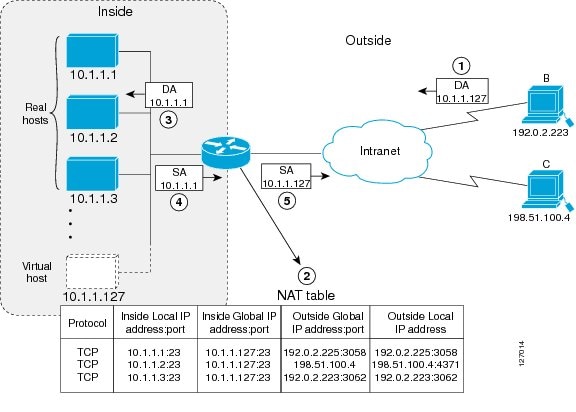|
Destination-Based NAT Using Route Maps
|
Cisco IOS
XE Release 2.1
|
The
Destination-Based NAT Using Route Maps feature adds support for
destination-based NAT using route maps.
|
|
NAT
Duplicate Inside Global Address
|
Cisco IOS
XE Release 2.1
|
The Cisco
IOS XE software supports the NAT Duplicate Inside Global Addresses feature.
|
|
NAT Host
Number Preservation
|
Cisco IOS
XE Release 2.1
|
For ease
of network management, some sites prefer to translate prefixes rather than
addresses. These sites want the translated address to have the same host number
as the original address. The two prefixes must be of the same length. The NAT
Host Number Preservation feature can be enabled by configuring dynamic
translation with the address pool of the type, match-host.
|
|
NAT MIB
Support
|
Cisco
IOS XE Release 3.15S
|
The NAT
MIB Support feature supports, IETF Behave Draft, Definitions of Managed Objects
for Network Address Translators (NAT). Only regular NAT is supported, NAT 64 is
not supported.
|
|
NAT
Performance Enhancement—Translation Table Optimization
|
Cisco IOS
XE Release 2.1
|
The NAT Performance Enhancement—Translation Table Optimization feature provides greater structure for storing translation
table entries and an optimized lookup in the table. The optimized lookup table enables associating table entries to IP connections.
|
|
NAT Route
Maps Outside-to- Inside Support
|
Cisco IOS
XE Release 2.2
|
The NAT Route Maps Outside-to-Inside Support feature enables the deployment of a NAT route map configuration that will allow
IP sessions to be initiated from the outside to the inside.
|
|
NAT
Static IP Support
|
Cisco IOS
XE Release 2.1
|
The NAT Static IP Support feature provides support for users with static IP addresses. It enables those users to establish
an IP session in a public wireless LAN environment.
|
|
NAT Timers
|
Cisco IOS
XE Release 2.1
|
The NAT
Timers feature allows you to change the amount of time after which NAT
translations time out.
|
|
NAT
Translation of External IP Addresses Only
|
Cisco IOS
XE Release 2.1
|
To configure NAT for ignoring all embedded IP addresses of any application and traffic type, use the NAT Translation of External
IP Address Only feature .
|
|
Rate
Limiting NAT Translation
|
Cisco IOS
XE Release 2.1
|
The Rate
Limiting NAT Translation feature provides the ability to limit the maximum
number of concurrent Network Address Translation (NAT) operations on a router.
In addition to giving users more control over how NAT addresses are used, the
Rate Limiting NAT Translation feature can be used to limit the effects of
viruses, worms, and denial-of-service attacks.
|
|
VRF Scale
Increase in NAT
|
Cisco IOS
XE Release 3.10S
|
The VRF
Scale Increase in NAT feature provides the ability to increase the number of
virtual routing and forwarding (VRF) instances that are supported on NAT to
4000. This feature is enabled by default when NAT is configured. You cannot
disable this configuration.
No
commands were introduced or modified for this feature.
In Cisco
IOS XE Release 3.10S, support was added for Cisco CSR 1000V Series Routers.
In Cisco
IOS XE Release 3.10S, support was added for Cisco ISR 4400 Series Routers.
|
|
NAT
support on BDI interface
|
Cisco
IOS XE Denali 16.3.1
|
The NAT
support on BDI interface feature enables you to configure NAT on Bridge Domain
Interface (BDI).
No
commands were introduced or modified for this feature.
|
|
Multi-Tenant support for NAT
|
Cisco
IOS XE Denali 16.3.1
|
With Multi-Tenant support for NAT feature, the configuration changes of a VRF instance do not interrupt the traffic flow
of other VRFs in the network.
No
commands were introduced or modified for this feature.
|
|
Bypass
NAT functionality
|
Cisco
IOS XE Denali 16.3.2
Cisco
IOS XE Everest 16.4.1
|
The Bypass NAT functionality feature enables you to permit an ACL with deny statements using a bypass pool. The Bypass NAT
functionality feature reduces the TCAM size by resolving the deny jump issue.
No commands were introduced or modified for this feature.
In Cisco IOS XE Denali 16.3 everest
Bypass
NAT functionality
.2, support was added for Cisco Cloud Services Router 1000V Series, Cisco ASR 1000 Series Routers with Route Processors (RP2
and RP3), Cisco 4000 Series Integrated Services Routers.
In Cisco IOS XE Everest 16.4.1, support was extended to Cisco ASR 1001-HX Router, Cisco ASR 1001-X Router, Cisco ASR 1002-HX
Router, Cisco ASR 1002-X Router.
|
|
IP Address Port Parity and Conservation
|
Cisco IOS XE Everest 16.5.1b
|
Added information on NAT pool overload of RTP packets during
ALG processing.
No commands were introduced or modified for this feature.
|





 Feedback
Feedback